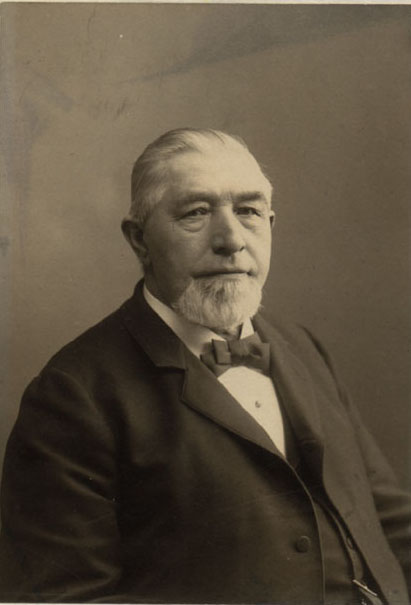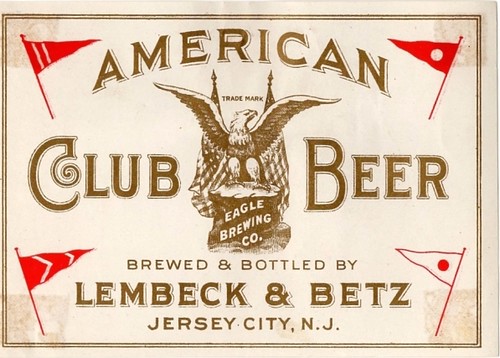
Today is the birthday of Henry B. Lembeck (April 8, 1826-July 26, 1904). He partner with John F. Betz (whose birthday is also today) to start The Lembeck and Betz Eagle Brewing Company in 1869, in Jersey City, New Jersey. It was originally known as the Henry Lembeck & John Betz Brewery, but changed its name to the Lembeck & Betz Eagle Brewing Co. in 1890. The brewery operated until prohibition in 1920. It was licensed in 1933 to begin brwong beer again, but never did so, effectively meaning it closed in 1920, or 1933, depending on how you want to look at it.

This is his biography from his Wikipedia page:
Born in Osterwick, Germany near Münster, he became a cabinet maker like his father and an apprentice at the age of 13. He was drafted into the army at the age of 20, but deserted during the German Revolution of 1848 and immigrated to the United States in 1849. Living in New York City, he worked first as a carpenter and then as a grocery clerk. In a few years, Lembeck set up his own successful grocery business. It was then that he met a successful brewer, John F. Betz, selling his beer in his store.
In 1869, Lembeck moved across the river and established a brewery with Betz in downtown Jersey City, New Jersey. The Lembeck and Betz Eagle Brewing Company would develop into one of the most successful breweries in the eastern United States producing a quarter of a million barrels of beer a year. As Lembeck grew financially successful, he also helped establish banks and real estate companies in Jersey City. Lembeck was the founder of the Greenville Banking and Trust Company and a director of the Third National Bank. He helped develop the township of Greenville (today it’s a section of Jersey City) through real estate development of undeveloped land. Lembeck discontinued home building over a dispute with the city regarding the quality of water supplied to the Greenville area. After his retirement his son Gustav took over running the brewery. The brewery closed during Prohibition in 1920 and later went out of business. He lived in Greenville with his wife Emma and children in a mansion on Columbia Place, which has since been renamed Lembeck Avenue.
Lembeck died in Jersey City and is buried in Bayview – New York Bay Cemetery in Jersey City. The Lembeck mansion was later donated by his widow to St. Anne’s Home for the Aged.

Here’s a short biography of Lembeck from Find-a-Grave:
Henry Lembeck was born near Münster, Germany. At the age of 20, he was drafted into the army, but deserted during the German Revolution of 1848 and immigrated to the United States in 1849. Living in New York City, he worked first as a carpenter and than as a grocery clerk. In a few years, Lembeck set up his own successful grocery business. It was then that he met a successful brewer, John F. Betz. In 1869, Lembeck moved across the river and established a brewery with Betz in downtown Jersey City. The Lembeck and Betz Eagle Brewing Company would develop into one of the most successful breweries in the eastern United States producing a quarter of a million barrels of beer a year. As Lembeck grew financially successful, he also helped establish banks and real estate companies in Jersey City. His son Gustav took over running the brewery. He lived in Greenville (now part of Jersey City) with his wife Emma and children in a mansion on Columbia Place, which has since been re-named Lembeck Avenue.
This is a second biography of Lembeck from Find-a-Grave:
Henry Lembeck is of German parentage, his father having resided in Osterwick, Munster, Germany, where he followed the trade of a cabinetmaker. He married Elizabeth Wenning, of the same town, and had children, Elizabeth, Catrina, Bernard (deceased), Henry and Joseph. Henry was born on the 8th of April, 1826, in Osterwick, where he remained until eighteen years of age. He received in youth a rudimentary education, and on the death of his father, when his son was fourteen years of age, became an apprentice to the cabinet-maker’s trade, serving three years in that capacity. For two and a half years he was employed as a journeyman, when, being drafted into the German army, he did duty as a soldier for two and a half years. His strong love of liberty, however, found expression in the revolutionary sentiments declared by him, which rendered his presence in his native land uncomfortable. He was therefore induced to emigrate to America, and on landing in New York at once resumed his trade, that of a cabinet-maker. Jersey City then became his place of residence,after which he became the agent for the sale of the ale made at the brewery of John F. Betz, of New York. This was continued until 1870, when, in connection with John Betz, he established the firm, of Lembeck & Betz,of which ale is the staple product. They speedily won an extended reputation for the excellence of their ale, and created a wide demand for it in New York City and the vicinity. He was for four years a member of the Board of Public Works of Jersey City, two years of which period he was its president. He is also a director of the E.B. Parsons Malting Company of Rochester, N.Y. He is in religion a Catholic, and identified with St. Paul’s Catholic Church of Greenville.

The Lembeck and Betz Eagle Brewing Company in 1910.
And this is a history of his brewery from its Wikipedia page:
The Lembeck and Betz Eagle Brewing Company was founded in 1869 by Henry B. Lembeck and John F. Betz in Jersey City, in Hudson County, New Jersey, United States. The brewery, bounded by 9th, 10th, Grove, and Henderson streets in downtown Jersey City, developed into one of the most famous, best-equipped, and financially successful breweries on the East Coast of the United States. In 1889, Lembeck started producing lager beer in addition to the traditional pale ale they had been brewing. The brewery grew through the later part of the 19th century, eventually occupying seventeen city lots. The company was incorporated in May 1890. Since 1869, the brewery grew to become the fourth-largest brewery in New Jersey.
Lembeck died in 1904 and his sons Gustav and Otto took over running the brewery. The brewery closed during Prohibition. The facility was later sold and converted into a refrigeration plant. In 1984, the area was designated the Lembeck and Betz Eagle Brewing Company District on the National Register of Historic Places. The brewery buildings were demolished in 1997.
This history of the brewery is from Jersey City, Past and Present:
Business partners Henry Lembeck and John F. Betz founded one of the most famous, best-equipped, and financially successful breweries on the East Coast of the United States. By 1889, it manufactured fifty thousand barrels of ale and port and 250,000 barrels of beer per year in a state of the art facility valued at a million dollars and worth three million dollars in total assets.
Henry Lembeck was born at Osterwick, Mu[e]nster, Germany, on April 8, 1826. He adopted his father’s trade of cabinet making starting as an apprentice at age thirteen. He served four years as a journeyman and expected to complete his training in Paris, France, when he was drafted into the German army in 1846, a year prior to the revolution. A genealogical investigation by Lembeck’s descendants has documented that while serving in the military, Lembeck, dressed in civilian attire, frequently attended and participated at rallies of the insurgents. After a furlough granted in March 1849, he did not return to his regiment and seems to have immigrated to the United States. An investigation in 1850 was conducted and he was “declared a deserter.”
After working as a carpenter for the Herring Safe Company in New York City, Lembeck became the clerk to a grocer; and three years later he bought his own business that developed from a grocery store to a market-gardening firm. While his business flourished, Lembeck also became a sales agent for the brewery of John F. Betz of New York. In 1869, Lembeck moved to Jersey City and established with Betz a brewery to manufacture ale and porter on Ninth Street. The Betz family had already established a reputation as brewers both in the United States and Germany.
With Lembeck’s newly acquired business savvy and Betz’s background in the production of ale and porter, the partnership was established on sound footing. The Jersey City brewing facility and operation expanded. Lembeck astutely noted the diminishing taste for ale in the United States, and in 1889 added the production of the more popular beverage of lager beer to the business. Lembeck became president of the company and incorporated the brewery into a cooperative stock company in May 1890. Betz was the vice president of the company.
A biography of Lembeck states, “[he] had the complete management of the business, assumed full responsibility of its direction, and consequently must receive the credit for its success and growth” (“Biography of Henry B. Lembeck,” 2). The brewery’s physical plant begun on Ninth Street was enlarged to accommodate the required refrigeration and storage of beer and eventually occupied seventeen city lots. A malt house, H.F. Lembeck & Company at Watkins, New York, at the head of Seneca Lake, complemented the brewing firm.
Along with his business success, Lembeck took a strong interest in the Jersey City, his permanent residence. He was one of the founders the Greenville Banking and Trust Company, became vice president of the Third National Bank of Jersey City, and served with other corporations such as the Hudson Real Estate Company of which he was a director. In 1898 Lembeck built the Hudson Building at 13-15 Ocean Avenue. The stone Romanesque Revival structure at the corner of Lembeck and Ocean Avenues consecutively housed the Hudson Real Estate Company and the Greenville Bank and Trust Company with which he was associated. After a renovation in 1970, the Hudson Building became a 22-unit apartment.
Lembeck owned large tracks of land in Greenville and helped with its development. He donated property for the extension of Columbia Park (today Bartholdi Avenue). His earlier carpentry training prompted him to build a reported 32 to 43 houses in Jersey City prior to 1895 and to participate in their construction as both architect and supervising contractor. Lembeck discontinued home building over a dispute with the city regarding the quality of water supplied to the Greenville area and complained of the loss of tenants willing to rent his properties.
Lembeck lived in the home that he designed at 46 Columbia Place (today Lembeck Avenue) and Old Bergen Road. The modest-looking red brick structure has a decorative cornice painted gray with dentil molding and corner brackets. The center section of the house features a recessed gray wood and glass door reached from the concrete riser and has an open pediment supported by brackets over a double window with semicircular transom; the adjoining sections of building are topped by pyramids over the roofline. The Lembeck mansion was later donated by his widow to St. Anne’s Home for the Aged at 198 Old Bergen Road and serves as the administrative building; St. Ann’s became part of the York Street Project, run by the Sisters of St. Joseph of Peace, in 1987.
Lembeck died at his residence on July 25, 1904; he was president of Lembeck and Betz at the time of his death. He is buried in the family plot in the Bayview-New York Bay Cemetery.

The tagline in this ad is great: “The beer that made Milwaukee jealous.”








Leave a Reply